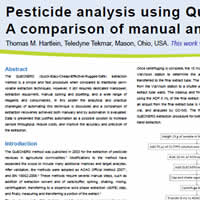Resumo do Pôster:
1. Introduction
The QuEChERS method was published in 2003 for the extraction of pesticide residues in agricultural commodities.1 Modifications to the method have expanded the scope to include many additional matrices and target analytes. After validation, the methods were adopted as AOAC Official Method 20071, and EN 15662:2008.2 These methods require several manual steps, such as addition of extraction solvent and of salts/buffer, spiking, shaking, mixing, centrifugation, transferring to a dispersive solid phase extraction (dSPE) step, and finally measuring and transferring a portion of the extract.3
The rise in popularity of the technique and the increase in sample testing loads have lead to automation as a possible solution to increase productivity. This work presents a system designed and optimized to automate the QuEChERS sample extraction workflow. Results from both the automated and manual QuEChERS extractions are compared using the AOAC Method 2007.1
2. Purpose
Evaluate the performance of a new developed system to automate the QuEChERS extraction method.
3. Method
The QuEChERS extractions were performed by the automatic system and manually by an analyst. Figure 1 shows the steps for the AOAC QuEChERS extraction procedure for both the automatic and manual hand extraction. The QuEChERS steps allways manually performed were the sample weighing and the transfer of the extract to an autosampler vial.
Six pounds of apples were prepared according to the procedure described in the AOAC Official Method1. The target pesticides were: Trifluralin, Atrazine, Chlorothalonil, Chloropyrophos-methyl, Cyprodinil, Procymidone, 2,4’-DDD, Kresoxim-methyl, Bifenthrin, Lambda-Cyhalothrin Cis- and Trans-Permethrin.
Weigh 15 g of sample in 50 mL centrifuge tube |
Add 75 µL of IS (TPP) solution and QC spike solution if necessary |
Add 15 mL of ACN containing 1% HAc |
Add QuEChERS extraction salt |
Cap and shake vigorously for 1 min |
Centrifuge for 5 min |
Transfer 8 mL to AOAC dSPE 15 mL tube |
Sake for 1 min, centrifuge for 5 min |
Transfer extract to autosampler vial. Analyse by GC-MS. |
Figure 1. AOAC QuEChERS extraction steps. |
4. Results and Discussion
Two sets of data were analyzed to illustrate the differences between using the automatic and manual QuEChERS extraction.
Linearity: Six matrix blanks were extracted with internal standard (triphenyl phosphate, TPP) and surrogates and were spiked with a prescribed amount of a 2 μg/mL calibration stock standard. The calibration ranges for all compounds were performed at 5 - 400 ng/g. The calibrations were extracted both by hand and by automation. Each calibration curve was prepared at levels of 5, 10, 20, 50, 100, and 400 ng/g. The R2 values for the automatic extraction ranged from 0.9970 to 0.9998 and for manual from 0.9926 to 0.9994.
Recovery and Reproducibility: A 6 μg/mL stock AOAC QC pesticide standard was used to fortify the homogenized apple samples. The automatic system spiked the apples samples with 50 and 250 μL of the AOAC QC check standard yielding 20 and 100 ng/g check samples. The same process was done for the manual extractions using a micro syringe. These QC samples were quantitated against their corresponding matrix-spike calibration curve. The analyses were performed in replicates of five (n=5). When using the automatic system, average recoveries of 100.8% for 20 ng/g spike and 97.1% for 100 ng/g spike, and average precision of 4.1%RSD for the low spike and 3.4%RSD for the high spike were observed. The manual QuEChERS exhibit slightly lower recoveries (average of 87.3% for 20 ng/g spike and 92.1% for 100 ng/g spike) and comparable precision (RSD 4-5% on average for both spikes).
5. Conclusion
By automating the liquid handling, the addition of salt/buffers, sample mixing, pipetting, and liquid level sensing, the extraction process is fast, and easy. The automatic system not only offers time and labor savings, but also improves extraction precision and accuracy. All of the pesticides give excellent spike recoveries on average 100.8% for the 20 ng/g spike and 97.1% for the 100 ng/g spike and excellent precision on average of 3 - 4% RSD.
6. References
- AOAC Official Method 2007.07 Pesticide Residues in Food by Acetonitrile Extraction and Partitioning with Magnesium Sulfate. Gas Chromatography/Mass Spectrometry and Liquid Chromatography/ Tandem Mass Spectrometry, First Action 2007.
- European Committee for Standardization/Technical Committee CEN/TC275 (2008), Foods of plant origin: Determination of pesticide residues using GC-MS and/or LC-MS/MS following acetonitrile extraction/ partitioning and cleanup by dispersive SPE QuEChERS-method.
- M. Anastassiades: QuEChERS a mini-multiresidue method for the analysis of pesticide residues in low-fat products. (http://quechers.cvua-stuttgart.de/pdf/reality.pdf consultado em 25/06/2015.)
|

